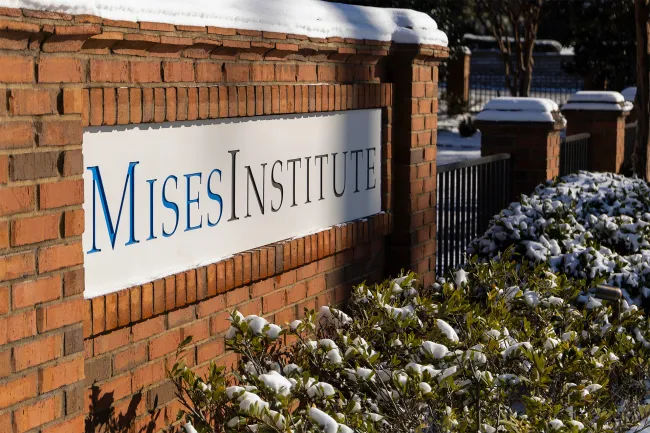Liberalism: In the Classical Tradition
1. The Organization of the Economy
It is possible to distinguish five different conceivable systems of organizing the cooperation of individuals in a society based on the division of labor: the system of private ownership of the means of production, which, in its developed form, we call capitalism; the system of private ownership of the means of production with periodic confiscation of all wealth and its subsequent redistribution; the system of syndicalism; the system of public ownership of the means of production, which is known as socialism or communism; and, finally, the system of interventionism.
The history of private ownership of the means of production coincides with the history of the development of mankind from an animal-like condition to the highest reaches of modern civilization. The opponents of private property have gone to great pains to demonstrate that in the primeval beginnings of human society the institution of private property still did not exist in a complete form because a part of the land under cultivation was subject to periodic redistribution. From this observation, which shows that private property is only a “historical category,” they have tried to draw the conclusion that it could once again be quite safely dispensed with. The logical fallacy involved in this reasoning is too flagrant to require any further discussion. That there was social cooperation in remote antiquity even in the absence of a completely realized system of private property cannot provide the slightest proof that one could manage without private property just as well at higher stages of civilization. If history could prove anything at all in regard to this question, it could only be that nowhere and at no time has there ever been a people which has raised itself without private property above a condition of the most oppressive penury and savagery scarcely distinguishable from animal existence.
The earlier opponents of the system of private ownership of the means of production did not attack the institution of private property as such, but only the inequality of income distribution. They recommended the abolition of the inequality of income and wealth by means of a system of periodical redistribution of the total quantity of commodities or, at least, of land, which was at that time virtually the only factor of production taken into consideration. In the technologically backward countries, where primitive agricultural production prevails, this idea of an equal distribution of property still holds sway today. People are accustomed to call it agrarian socialism, though the appellation is not at all apposite since this system has nothing to do with socialism. The Bolshevist revolution in Russia, which had begun as socialist, did not establish socialism in agriculture?i.e., communal ownership of the land?but, instead, agrarian socialism. In large areas of the rest of Eastern Europe, the division of big landed estates among the small farmers, under the name of agrarian reform, is the ideal espoused by influential political parties.
It is unnecessary to enter further into a discussion of this system. That it must result in a reduction in the output of human labor will scarcely be disputed. Only where land is still cultivated in the most primitive way can one fail to recognize the decrease in productivity which follows upon its division and distribution. That it is utterly senseless to break up a dairy farm equipped with all the devices of modern technology will be conceded by everyone. As for the transference of this principle of division and distribution to industry or commercial enterprises, it is altogether unthinkable. A railroad, a rolling mill, or a machine factory cannot be divided up. One could undertake to carry out the periodical redistribution of property only if one first completely broke up the economy based on the division of labor and the unhampered market and returned to an economy of self-sufficient farmsteads existing side by side without engaging in exchange.
The idea of syndicalism represents the attempt to adapt the ideal of the equal distribution of property to the circumstances of modern large-scale industry. Syndicalism seeks to invest ownership of the means of production neither in individuals nor in society, but in the workers employed in each industry or branch of production.1
Since the proportion in which the material and the personal factors of production are combined is different in the different branches of production, equality in the distribution of property cannot be attained in this way at all. From the very outset the worker will receive a greater portion of property in some branches of industry than in others. One has only to consider the difficulties that must arise from the necessity, continually present in any economy, of shifting capital and labor from one branch of production to another. Will it be possible to withdraw capital from one branch of industry in order thereby more generously to equip another? Will it be possible to remove workers from one branch of production in order to transfer them to another where the quota of capital per worker is smaller? The impossibility of such transfers renders the syndicalist commonwealth utterly absurd and impracticable as a form of social organization. Yet if we assume that over and above the individual groups there exists a central power that is entitled to carry out such transfers, we are no longer dealing with syndicalism, but with socialism. In reality, syndicalism as a social ideal is so absurd that only muddleheads who have not sufficiently thought the problem through have ventured to advocate it on principle.
Socialism or communism is that organization of society in which property-the power of deploying all the means of production-is vested in society, i.e., in the state, as the social apparatus of compulsion and coercion. For a society to be judged as socialist it is of no consequence whether the social dividend is distributed equally or according to some other principle. Neither is it of decisive significance whether socialism is brought about by a formal transfer of the ownership of all the means of production to the state, the social apparatus of compulsion and coercion, or whether the private owners retain their property in name and the socialization consists in the fact that all these “owners” are entitled to employ the means of production left in their hands only according to instructions issued by the state. If the government decides what is to be produced and how, and to whom it is to be sold, and at what “price,” then private property still exists in name only; in reality, all property is already socialized, for the mainspring of economic activity is no longer profit-seeking on the part of entrepreneurs and capitalists, but the necessity of fulfilling an imposed duty and of obeying commands.
Finally, we still have to speak of interventionism. According to a widespread opinion, there is, midway between socialism and capitalism, a third possibility of social organization: the system of private property regulated, controlled, and guided by isolated authoritarian decrees (acts of intervention).
The system of periodical redistribution of property and the system of syndicalism will not be discussed in what follows. These two systems are not generally at issue. No one who is in any way to be taken seriously advocates either one. We have to concern ourselves only with socialism, interventionism, and capitalism.
- 1[1] Syndicalism as an end and as a social idea is not to be confused with syndicalism as a trade-union tactic (the “direct action” of the French syndicalists). Of course, the latter can serve as a means in the struggle for the realization of the syndicalist ideal, but it can also be made to serve other ends incompatible with that ideal. One can strive, for example—and this is precisely what some of the French syndicalists hope to do—to achieve socialism by resorting to syndicalist tactics.

